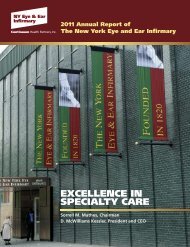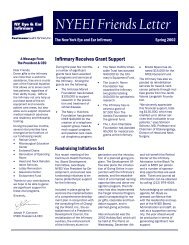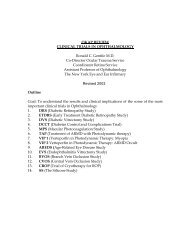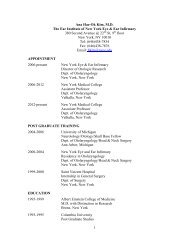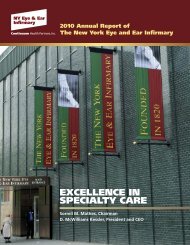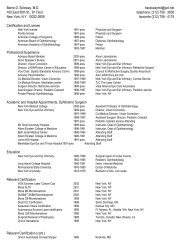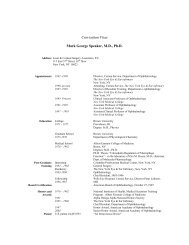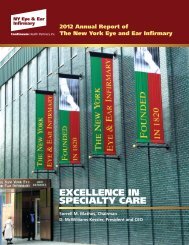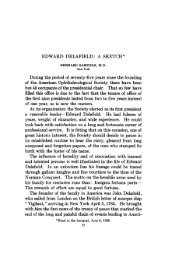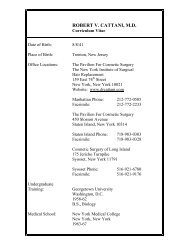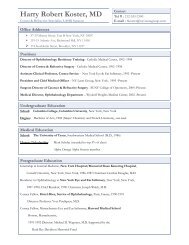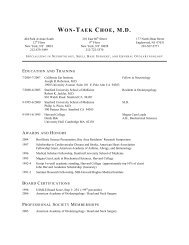The Impact on Glaucoma from the OUTSIDE IN - New York Eye and ...
The Impact on Glaucoma from the OUTSIDE IN - New York Eye and ...
The Impact on Glaucoma from the OUTSIDE IN - New York Eye and ...
You also want an ePaper? Increase the reach of your titles
YUMPU automatically turns print PDFs into web optimized ePapers that Google loves.
CME POST TEST<br />
How OSD Affects IOP<br />
<str<strong>on</strong>g>The</str<strong>on</strong>g> <str<strong>on</strong>g>Impact</str<strong>on</strong>g> <strong>on</strong> <strong>Glaucoma</strong> <strong>from</strong> <strong>the</strong> <strong>OUTSIDE</strong> <strong>IN</strong><br />
To obtain AMA PRA Category 1 Credit for this activity, you<br />
must complete <strong>the</strong> CME Post Test by writing <strong>the</strong> best answer to<br />
each questi<strong>on</strong> in <strong>the</strong> Answer Box located <strong>on</strong> <strong>the</strong> Activity<br />
Evaluati<strong>on</strong>/Credit Request form <strong>on</strong> <strong>the</strong> following page.<br />
To take this post test/evaluati<strong>on</strong> <strong>on</strong>line, please see<br />
"To Obtain AMA PRA Category 1 Credit" <strong>on</strong> page 2.<br />
1. In what percentage of patients with glaucoma or ocular<br />
hypertensi<strong>on</strong> treated with ocular antihypertensives are<br />
symptoms of ocular surface disease (OSD) present?<br />
a. 25<br />
b. 50<br />
c. 75<br />
d. 100<br />
2. Which of <strong>the</strong> following is directly correlated to <strong>the</strong> prevalence<br />
of OSD?<br />
a. Age 65 years or younger<br />
b. <str<strong>on</strong>g>The</str<strong>on</strong>g> number of years in which eyeglasses are worn<br />
c. <str<strong>on</strong>g>The</str<strong>on</strong>g> number of instilled ocular antihypertensive drops<br />
d. A humid climate<br />
3. Which of <strong>the</strong> following is/are a typical finding of OSD?<br />
a. Patient-reported ocular discomfort<br />
b. Redness of <strong>the</strong> eye<br />
c. Pathology of <strong>the</strong> corneal epi<strong>the</strong>lium<br />
d. All <strong>the</strong> above are typical findings of OSD<br />
4. A 67-year-old male patient presents to <strong>the</strong> ophthalmology clinic<br />
for a follow-up appointment for glaucoma management. <str<strong>on</strong>g>The</str<strong>on</strong>g><br />
patient has been treated with latanoprost with benzalk<strong>on</strong>ium<br />
chloride (BAK) for 1 year. He complains of eye irritati<strong>on</strong>, blurred<br />
<strong>and</strong> fluctuating visi<strong>on</strong>, <strong>and</strong> difficulty working <strong>on</strong> <strong>the</strong> computer for<br />
an extended period of time. He has been using preservativefree<br />
tear supplements for his symptoms. <str<strong>on</strong>g>The</str<strong>on</strong>g> patient’s<br />
intraocular pressure (IOP) is 24 mm Hg (it was 16 mm Hg at<br />
<strong>the</strong> 6-m<strong>on</strong>th follow-up appointment). On examinati<strong>on</strong>, <strong>the</strong><br />
patient has c<strong>on</strong>junctival redness, superficial punctate keratitis,<br />
<strong>and</strong> poor corneal tear film. Which of <strong>the</strong> following is <strong>the</strong> most<br />
likely cause of <strong>the</strong> patient’s poorly c<strong>on</strong>trolled IOP?<br />
a. Patient tolerance to <strong>the</strong> pharmacological effects of<br />
latanoprost with BAK <strong>the</strong>rapy<br />
b. Worsening of glaucoma<br />
c. Drug interacti<strong>on</strong> with preservative-free tear<br />
supplements<br />
d. Suboptimal adherence to latanoprost with BAK <strong>the</strong>rapy<br />
5. Dry eye affects patient quality of life in a similar magnitude<br />
to that experienced in _____________.<br />
a. Unstable angina<br />
b. Diabetes mellitus<br />
c. Osteoporosis<br />
d. Hypertensi<strong>on</strong><br />
6. Which is NOT a deleterious effect of BAK?<br />
a. Disrupti<strong>on</strong> of tight juncti<strong>on</strong> proteins<br />
b. Programmed cell death, apoptosis, <strong>and</strong> necrosis in<br />
epi<strong>the</strong>lial cells<br />
c. IOP elevati<strong>on</strong><br />
d. Incitati<strong>on</strong> of cytokines, chemotactic factors, <strong>and</strong><br />
metalloproteinases<br />
7. A 68-year-old white female presents to <strong>the</strong> ophthalmology<br />
clinic with complaints of red, irritated eyes. <str<strong>on</strong>g>The</str<strong>on</strong>g> patient is<br />
treated with latanoprost with BAK for IOP lowering. On<br />
examinati<strong>on</strong>, <strong>the</strong> patient has marked hyperemia of both<br />
eyes. Which of <strong>the</strong> following <strong>the</strong>rapeutic strategies would be<br />
most likely to completely eliminate <strong>the</strong> patient’s red eyes?<br />
a. Change <strong>the</strong>rapy to preservative-free tafluprost<br />
b. Add preservative-free dexamethas<strong>on</strong>e, 0.01%<br />
c. Change <strong>the</strong>rapy to travoprost with SofZia<br />
d. Initiate a drop holiday<br />
8. Which statement regarding n<strong>on</strong>-BAK preserved prostagl<strong>and</strong>in<br />
analog ocular antihypertensives is true?<br />
a. Preservative-free ocular antihypertensives are not as<br />
effective as BAK-preserved ocular antihypertensives in<br />
terms of lowering IOP<br />
b. Travoprost with SofZia has been found to be ineffective<br />
<strong>and</strong> not well tolerated<br />
c. Preservative-free ocular antihypertensives are more<br />
effective than BAK-preserved ocular antihypertensives<br />
in terms of lowering IOP.<br />
d. Preservative-free tafluprost has been found to have an<br />
IOP-lowering effect of up to 30%<br />
9. Which of <strong>the</strong> following treatment strategies is/are <strong>the</strong> most<br />
reas<strong>on</strong>able opti<strong>on</strong>(s) for addressing <strong>the</strong>rapeutic<br />
n<strong>on</strong>adherence due to ocular surface complaints in a patient<br />
currently <strong>on</strong> a prostagl<strong>and</strong>in analog with BAK?<br />
a. Laser trabeculoplasty<br />
b. Switch to a n<strong>on</strong>-BAK preserved or preservative-free<br />
ocular antihypertensive <strong>the</strong>rapy<br />
c. Add artificial tears to <strong>the</strong> current regimen<br />
d. A <strong>and</strong> B are <strong>the</strong> most reas<strong>on</strong>able opti<strong>on</strong>s<br />
10. A 73-year-old African American female patient presents to<br />
<strong>the</strong> ophthalmology clinic. <str<strong>on</strong>g>The</str<strong>on</strong>g> patient has been <strong>on</strong> an IOPlowering<br />
regimen of brim<strong>on</strong>idine with Purite <strong>and</strong> latanoprost<br />
with BAK. She is complaining of ocular irritati<strong>on</strong> <strong>and</strong> foreign<br />
body sensati<strong>on</strong>. Ocular examinati<strong>on</strong> shows c<strong>on</strong>junctival<br />
redness, rapid tear film break-up, <strong>and</strong> corneal fluorescein<br />
staining. <str<strong>on</strong>g>The</str<strong>on</strong>g> patient’s IOP is 24 mm Hg <strong>and</strong> she reports<br />
being adherent to her ocular antihypertensive <strong>the</strong>rapy.<br />
Which of <strong>the</strong> following is likely <strong>the</strong> most appropriate<br />
<strong>the</strong>rapeutic strategy for this patient?<br />
a. Initiate a drop holiday <strong>and</strong> begin preservative-free<br />
dexamethas<strong>on</strong>e, 0.01%, followed by re-initiati<strong>on</strong> of<br />
ocular antihypertensive <strong>the</strong>rapy with a preservative-free<br />
formulati<strong>on</strong><br />
b. Initiate a drop holiday <strong>and</strong> begin IOP-lowering <strong>the</strong>rapy<br />
with an oral carb<strong>on</strong>ic anhydrase inhibitor, followed by<br />
re-initiati<strong>on</strong> of ocular antihypertensive <strong>the</strong>rapy with a<br />
preservative-free formulati<strong>on</strong><br />
c. Initiate a drop holiday <strong>and</strong> begin preservative-free<br />
dexamethas<strong>on</strong>e, 0.01%, followed by re-initiati<strong>on</strong> of<br />
ocular antihypertensive <strong>the</strong>rapy with brim<strong>on</strong>idine with<br />
Purite <strong>and</strong> travoprost with SofZia<br />
d. Initiate a drop holiday <strong>and</strong> begin preservative-free<br />
dexamethas<strong>on</strong>e, 0.01%; recommend laser<br />
trabeculoplasty within 1 week<br />
11



